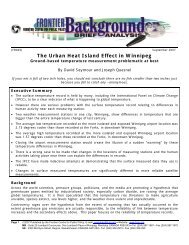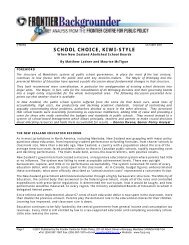PDF version (27 slides) - Frontier Centre for Public Policy
Create successful ePaper yourself
Turn your PDF publications into a flip-book with our unique Google optimized e-Paper software.
GREEN TRAINWRECKS OF MANITOBA<br />
Why Manitoba is not Smart Green<br />
PRESENTATION TO:<br />
St. Boniface<br />
Rotary Club<br />
January 8, 2008<br />
By Peter Holle<br />
FRONTIER CENTRE<br />
FOR PUBLIC POLICY
TODAY’S DISCUSSION<br />
Manitoba Gov’t: “Our Province is a “Green” leader”<br />
Climate Change Politics vs. Good <strong>Policy</strong><br />
Three Green Train wrecks:<br />
– Ethanol<br />
– Lake Winnipeg<br />
– Manitoba Hydro – Transmission line/subsidies<br />
Principles of Smart Green <strong>Policy</strong><br />
Moving <strong>for</strong>ward
Present<br />
Manitoba<br />
government<br />
portrays<br />
itself as a<br />
“Green”<br />
Leader on its<br />
website.
The website also<br />
highlights hli ht a 2005<br />
BusinessWeek ranking<br />
placing our premier<br />
alongside Tony Blair and<br />
Arnold Schwarzenegger
Man-Made Made Climate Change Theory<br />
Carbon dioxide emissions from human activity is<br />
causing global warming<br />
Our high living standards and affluent<br />
consumption-based lifestyles are the problem<br />
Blames corporations, suburban sprawl (land<br />
development patterns), automobile society<br />
Answer = central planning, government action,<br />
United Nations etc. (Why politicians love it…
Man-Made Made Climate Change Politics<br />
– Class warfare and anti-corporatism<br />
“Many y factors including a lack of science education, a<br />
need to perpetuate themselves and "means justifies the<br />
end" thinking. The worst aspect is what I describe as the<br />
environmental movement has been hijacked by political<br />
activists who are using green rhetoric to cloak agendas<br />
that have more to do with anti-corporatism and class<br />
warfare than with ecology or the environment.”<br />
Patrick Moore, Co-founder of<br />
Green Peace in FC interview
A Great Central Planning Vehicle For Achieving Significant<br />
Control Over The Economic Life Of The Nation<br />
– The New Socialism<br />
“The environmental movement has been<br />
taken over by the socialists who lost power<br />
after the fall of the Soviet Union, because it<br />
became difficult to justify being a socialist<br />
any more in any realm except <strong>for</strong> the<br />
environmental realm. Polls showed that<br />
Americans were opposed to socialism<br />
except that they believed in government<br />
intervention to protect the environment. So<br />
socialists were drawn to the environmental<br />
movement and that changed the movement<br />
to its own detriment.”<br />
Randall O’Toole, Senior<br />
Fellow, Cato Institute in a<br />
FC interview
Climate Change Reality -1<br />
Global temperature is related to many factors -<br />
primarily solar activity – correlates with sunspots<br />
CO2 levels do not correlate with temperatures –<br />
especially on a geologic time scale
Climate Change Reality – 2<br />
Measurement Issues<br />
Urban heat island effects = major measurement problems<br />
Winnipeg Forks always warmer than airport.<br />
Close airport measurement = global warming
Climate Change Reality -2<br />
Lack of Context – surface temperature<br />
measurements only started in 1850s.<br />
If the thickness of a sheet of paper is .10<br />
millimetre, 100 pages would be<br />
approximately 1 cm thick.<br />
Assuming gp paper p<br />
records began in the<br />
middle 1800s, and that each year<br />
represents a sheet of paper, that would<br />
give us a small pile of about 150 pages<br />
or 1.5 cm of paper. The geological age<br />
of the Earth—4.55 billion years—would<br />
represent a stack of paper that is about<br />
45.5 km high.<br />
It is misleading to refer to temperatures<br />
recorded in the first 1.5 cm of a paper<br />
pile that is 45.5 km high and call them<br />
the hottest temperatures in history.
Three Manitoba Green <strong>Policy</strong> Train Wrecks<br />
Lake Winnipeg<br />
Ethanol<br />
Manitoba Hydro
Lake Winnipeg – Algae Blooms<br />
There are smart ways to control the nutrient<br />
load into Lake Winnipeg.<br />
But consider how much of the problem is<br />
beyond our control.<br />
According to the December 2006 final report<br />
of the Lake Winnipeg Stewardship Board:<br />
– 53% of the load comes from the U.S. and other<br />
provinces<br />
– 23% comes from natural sources<br />
– Less than a quarter comes from Manitoba sources<br />
with 15% from agriculture (only 1.5% from the much<br />
maligned pork industry)<br />
– 9 % comes from Winnipeg and other municipalities.
Lake Winnipeg – Grey Water Septic Field Fiasco<br />
To reduce nutrient loads into Lake Winnipeg, Manitoba is moving to<br />
ban grey water septic fields.<br />
It did this without expanding the holding lagoons so there are<br />
frequent harmful emergency discharges into natural water systems.<br />
The situation is so severe at Westhawk that they now dump the<br />
lagoons every 6 weeks instead of twice a year (spring and fall).<br />
Better policy can help Lake Winnipeg, including better policing of<br />
grey water fields and the use of newer technologies run on a<br />
contract basis (Privately owned and operated sequential batch<br />
reactors).<br />
Governments have a conflict of interest when they regulate<br />
themselves, so complicated and critical infrastructure should be<br />
separated and placed in the commercial sector.
Lake Winnipeg – City of Winnipeg<br />
The province is requiring Winnipeg to build a $1.2 billion waste<br />
water plant upgrade which will reduce the city’s 5% portion of<br />
nutrient load going into Lake Winnipeg to about 2.5%.<br />
It will remove both Phosphorus and Nitrogen, even though the<br />
scientific evidence is only strong <strong>for</strong> Phosphorus as the limiting<br />
factor <strong>for</strong> blue green algae production (many of the algae species<br />
can fix atmospheric Nitrogen, and are there<strong>for</strong>e not limited by<br />
Nitrogen in the water).<br />
This represents approximately $500 million extra cost <strong>for</strong> little<br />
environmental benefit.<br />
Proper risk and cost benefit analysis would free up<br />
resources <strong>for</strong> other green uses
Ethanol is Green<br />
“Good <strong>for</strong> the<br />
environment”<br />
“Good <strong>for</strong> the<br />
economy”<br />
But is it?
Inflation and Higher Taxes<br />
Ethanol is distilled from food crops.<br />
Pumping ethanol into the gas tank is like<br />
pumping food into it; the ethanol that fills a<br />
25-gallon tank takes 450 pounds of corn to<br />
make, enough to feed someone <strong>for</strong> a year.<br />
Increased demand <strong>for</strong> corn to make<br />
ethanol <strong>for</strong> fuel rather than food and feed<br />
has resulted in food prices arising at twice<br />
the rate of inflation. (Mexican food riots).<br />
All 11 billion bushels of corn produced in<br />
2006 would yield the equivalent of 3.9<br />
million barrels a day of gasoline or less<br />
than a fifth of 21 million barrels a day<br />
Americans consumed. (Won’t make a dent<br />
in U.S. energy import dependence)
Ethanol – Undermines Livestock Industry<br />
One of Manitoba’s Few Success Stories<br />
Canada is strategically positioned as a meat exporter and that<br />
should cause governments to re-think their devotion to ethanol, says<br />
the George Morris <strong>Centre</strong>, Canada’s top agriculture think tank.<br />
The <strong>Centre</strong> has released a review of federal/provincial supports <strong>for</strong><br />
grain-based ethanol, in the context of broader Cdn public policy.<br />
– “Canada's current plans to develop ethanol are far from strategic, given their<br />
effect so far on the country's beef and pork sectors.”<br />
– "Just because the U.S. is developing ethanol does not mean Canada should”<br />
– “Not only do the two countries have different public policy issues at stake, but "it<br />
looks more and more like the U.S. policy is just bad policy, so one sees little<br />
reason to emulate it."<br />
– “Considering the rationales the U.S. has cited <strong>for</strong> ethanol supports, the idea of<br />
Canada, a net exporter of oil, needing ethanol to wean itself from <strong>for</strong>eign oil<br />
dependence can be "immediately rejected as absurd.”<br />
Ethanol energy input only slightly less than energy output<br />
We pay higher taxes to damage the hog industry <strong>for</strong> little benefit<br />
Proper risk and cost benefit analysis would free up resources <strong>for</strong> other green uses
Manitoba Hydro – West Side Transmission Line<br />
Extra distance of 455 km – west side<br />
Line loss:<br />
– of 28 megawatts a year – enough to<br />
power 25,000 homes (all of Brandon).<br />
– Extra greenhouse gases of 40,000 cars<br />
every year<br />
– Export value of line loss will be hundreds<br />
of millions of dollars.<br />
More expensive, less robust system –<br />
smarter to separate lines to insure<br />
against weather disruptions
Manitoba Hydro – Un-Green Price Subsidies<br />
Hidden subsidies - $1.2 billion difference<br />
between market and cost. (2006)<br />
Like selling oil <strong>for</strong> $35 when market price is $90.<br />
Manitoba has among highest power<br />
consumption in the world (of clean energy).<br />
Political l pricing i cascades down into other<br />
subsidy programs (wind farm optics)<br />
Hidden subsidies <strong>for</strong> capital, income tax<br />
exemptions and more = artificially cheap power.
A SMARTER POLICY MIX ON ELECTRICITY<br />
PROMOTE WISER ENERGY USE WITH MARKET PRICING<br />
IF MANITOBA PRICED ELECTRICITY AT MARKET RATES IT<br />
WOULD CAPTURE $1.2 BILLION IN EXTRA REVENUE<br />
Some options – Tax or Spending item $ Mill<br />
• End payroll, capital and<br />
Payroll Tax 328<br />
corporate tax plus school Capital Tax 152.5<br />
portion of property tax<br />
Corporate Tax <strong>27</strong>8.1<br />
or<br />
Income Tax 2,159<br />
• Double roads budget and Provincial Sales Tax 1,3<strong>27</strong><br />
eliminate school portion of Roads 239<br />
property tax<br />
School portion-Property 550<br />
or<br />
Tax<br />
• Cut income tax by 56% vs Power Subsidy +1,200
HOW DO WE GET TO GREENER PRICING<br />
POLICY MIX?<br />
Transition programs to ease move to market<br />
pricing – “grandfathering”<br />
g<br />
Intelligent pricing – peak load pricing to shift<br />
demand<br />
Effective communications<br />
– Higher prices will promote conservation<br />
– Lower taxes will create jobs, investment,<br />
higher tax revenues<br />
– A way out of “Have Not” Province Box<br />
Political leadership – Incompetent political<br />
management strengthening privatization case
CROWN CORPORATIONS?<br />
LET’S MOVEON<br />
ON<br />
A decade on from the Manitoba<br />
government’s share offering<br />
and exit from the telephone<br />
business -<br />
– MTS earns twice the<br />
revenue of SaskTel.<br />
– MTS has 3 times the<br />
assets.<br />
– MTS is more profitable, on<br />
the basis of revenue, assets<br />
and equity.<br />
– MTS has 20% more jobs.<br />
Manitoba Hydro not run directly<br />
by “Green” politicians -<br />
3 Ti Bi ?<br />
3 Times Bigger?<br />
More jobs<br />
Larger tax base<br />
More investment
Smart Green Principles<br />
1. Rely on unbiased science<br />
Smart Green Principle<br />
Manitoba:<br />
Fail<br />
2. Focus on measurable results Fail<br />
3. Recognize wealth lhcreation as the wellspring <strong>for</strong><br />
Fil Fail<br />
environmental improvement<br />
4. Substitute risk and cost benefit analysis <strong>for</strong> the Fail<br />
precautionary principle<br />
5. Focus on incentives via property rights Fail<br />
6. Embrace environmentally friendly fi technology; Fil Fail<br />
7. Eliminate public sector conflicts of interest by separating<br />
resource ownership from regulation.<br />
Fail<br />
See <strong>Frontier</strong> <strong>Policy</strong> Series Paper No. 25 – An Environmental <strong>Policy</strong><br />
<strong>for</strong> the 21 st Century at www.fcpp.org
Smart Green Ideas to Reduce GHGs<br />
Smart Green Ideas <strong>for</strong> Reducing Greenhouse Gases Feds: Manitoba:<br />
Promote telecommuting Fail Fail<br />
Remove hidden subsidies that depress energy prices Fail Fail<br />
Cut federal equalization subsidies <strong>for</strong> cheap electricity<br />
in Québec and Manitoba<br />
Improve traffic flows by eliminating and synchronizing<br />
traffic lights<br />
Fail<br />
Winnipeg<br />
Expand car scrappage programs<br />
Fail<br />
Institute cabotage rights <strong>for</strong> truckers<br />
Fail<br />
Do smarter bio‐energy Fail Fail<br />
Pay farmers to conserve the land<br />
Pass<br />
Help end global farm subsidies<br />
Fail<br />
Consider nuclear power Pass NA
There is no Crisis<br />
The Environment Has Never Been Better<br />
Environmental Indicators 2000 Report -<br />
Levels of sulphur dioxide in the air fell roughly 60 percent between 1974 and 1997;<br />
Ambient lead concentrations fell 88 percent in Canada between 1974 and 1997;<br />
Levels of nitrogen dioxide measured in the air fell 19 percent between 1974 and 1997;<br />
Carbon monoxide levels fell 74 percent between 1974 and 1997, and;<br />
Levels of total suspended particulates fell 53 percent between 1974 and 1997.<br />
"Although there are still some local air quality concerns in Canada, overall air quality has improved dramatically.<br />
We meet the strictest health standards <strong>for</strong> each of these pollutants," said Laura Jones.<br />
The study provides further evidence of Canada's environmental improvement in other areas:<br />
a 130 percent increase, since 1975, in the percentage of harvested <strong>for</strong>est area that is replanted;<br />
an 11 percent decline, since 1984, in the number of provincial water quality readings exceeding local standards;<br />
a 56 percent increase in paper and glass recycling;<br />
a 198 percent increase, since 1973, in the amount of land set aside <strong>for</strong> parks, wilderness, and wildlife; an 84<br />
percent decline, since 1974, in the amount of DDE found in bird eggs near the great lakes;<br />
a 95 percent drop in the concentrations of dioxins and furans measured in great blue heron eggs on the West<br />
Coast, and;<br />
21 percent more of the municipal population across Canada was provided with waste-water water treatment between<br />
1983 and 1994.<br />
"One of the most serious environmental problems Canada faces<br />
today is the large gap between public perception and reality, which<br />
can lead to focusing on the wrong problems and the wrong solutions"
SUPPORT THE DISCUSSION ON SMART GREEN POLICY<br />
Donate to independent think<br />
tanks that question the status<br />
quo<br />
Non-partisan and non-political<br />
No government funding –<br />
allows more latitude and<br />
freedom from political<br />
interference<br />
– Thought Leadership<br />
– Stimulate discussion on<br />
controversial topics<br />
– Provide breathing room <strong>for</strong><br />
politicians scared of interest<br />
groups
Sign up <strong>for</strong> <strong>Frontier</strong> E-mails<br />
www.fcpp.org

















